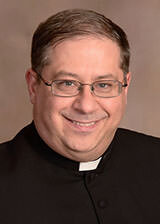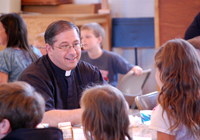Discover the Difference: Pastor shares his perspective on Catholic education
by Diocese of Des Moines | June 29, 2023

By Father Ken Halbur
Within the Catholic Church, we have had a long tradition of educating children as well as adults. The title often used for Jesus was Rabbi, which means teacher, and one of the things he did was teach us about the Father. This has been a mission of the Catholic Church for two thousand years, with formal Catholic schools for many hundreds of years.
The Catholic Church has a long history of promoting education, so when I hear the false phrase that the Church is against science, I laugh because we have been teaching and encouraging science for many years. Copernicus was a cleric of the Church, which means he received minor orders. Gregor Mendel, an Augustinian friar, pioneered modern genetics; Monsignor Georges Lemaitre proposed the basics for the Lemaitre/Hubble Constant (the big bang theory). It was renamed to the Hubble-Lemaitre law a few years ago.
science, I laugh because we have been teaching and encouraging science for many years. Copernicus was a cleric of the Church, which means he received minor orders. Gregor Mendel, an Augustinian friar, pioneered modern genetics; Monsignor Georges Lemaitre proposed the basics for the Lemaitre/Hubble Constant (the big bang theory). It was renamed to the Hubble-Lemaitre law a few years ago.
There are over 1.9 million students in Catholic elementary schools in the United States and over 32 million worldwide. To put that number in perspective, 17 percent of all students in the world go to a Catholic school, and in less developed countries, the percentage of Catholic-educated children is much higher.
The first Catholic school in the United States was opened in 1606 by Franciscan missionaries. Education has been the mission of the Church ever since Jesus walked the earth. Remember, he commands us to go out to all the nations and preach the Gospel. While a school is not the primary mission of the Catholic Church, it helps us with our primary goal: to bring all people to Christ and thus to heaven.
I often hear that it is too expensive for families to send their children to Catholic school, but many resources are available to help families afford a Catholic education. One of the great programs is Catholic Tuition Organization which provides tuition assistance based on need. Additionally, with the expansion of school choice in Iowa to include Education Savings Accounts (ESAs), Catholic education is even more accessible to families across the state. Click here to learn more about ESAs in Iowa.
Parents sacrifice financially to send their children to a Catholic school with tuition payments and by giving of their time, talent, and treasure. Teachers, faculty, and administration give because their salary could be higher by working for the public schools. Parishioners and other family and friends help by donating funds, supporting fundraisers, and the many other events that go on in the school. Catholic schools have been a wonderful part of our tradition, and it has been such a blessing to be a part of all the schools I have been blessed to serve.
Father Ken Halbur is pastor at St. Luke the Evangelist Parish and School in Ankeny. The newest school in the Diocese of Des Moines, St. Luke the Evangelist Catholic School is recognized as an Honor Plus School by the Iowa Department of Education for its efforts to enact Positive Behavioral Interventions and Supports. St. Luke provides kindergarten through eighth-grade students with an education rooted in Catholic values that provides a caring, creative, and quality learning environment. Prior to his time at St. Luke, he was the pastor of Holy Spirit Parish in Creston, where St. Malachy Catholic School resides.
The Diocese of Des Moines Catholic Schools includes 16 schools that serve more than 6,300 students across central and southwest Iowa. Catholic schools in the Des Moines Diocese build Christ-centered, collaborative, inclusive partnerships with parents, students, and parishes to provide students with innovative academic excellence and inspirational faith formation. To learn more about Catholic schools in the Diocese of Des Moines, visit www.dmdiocese.org/catholic-schools or email grow@dmdiocese.org.